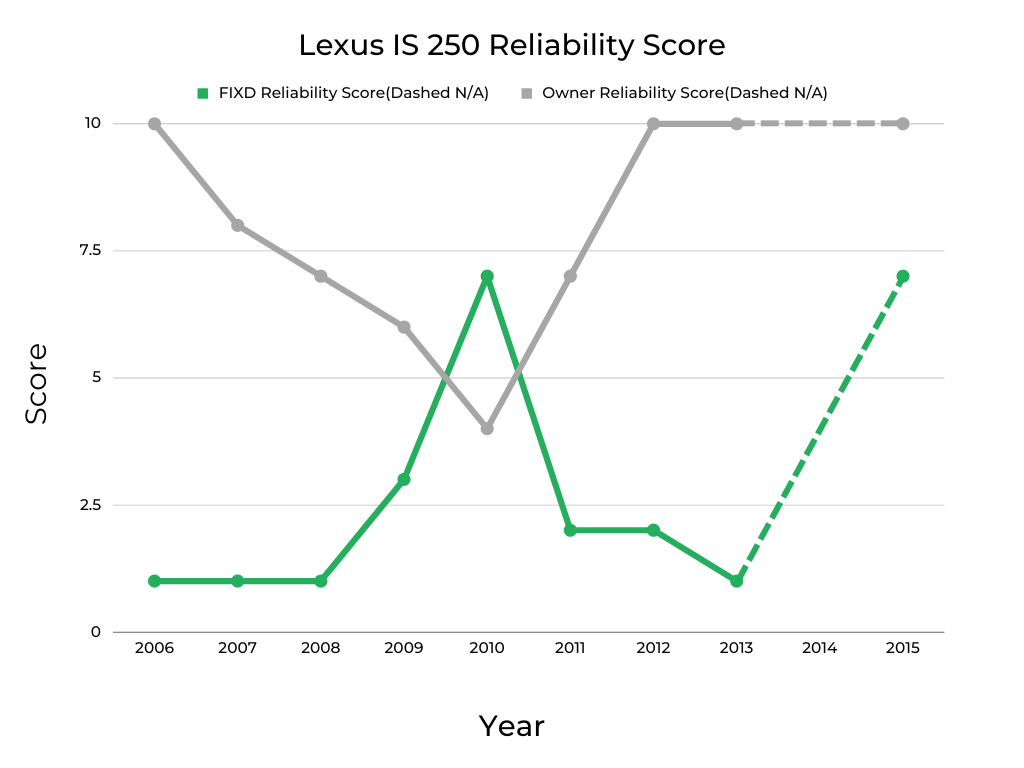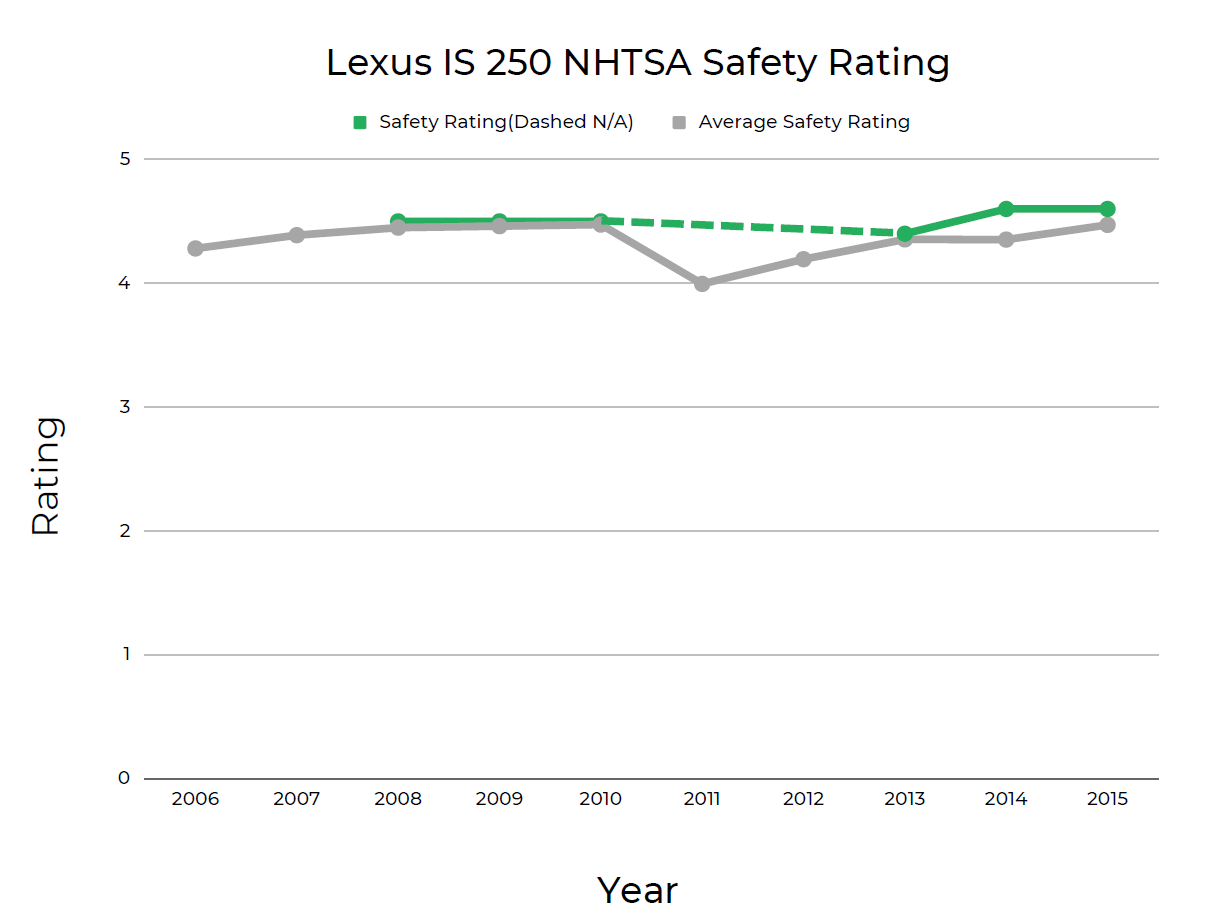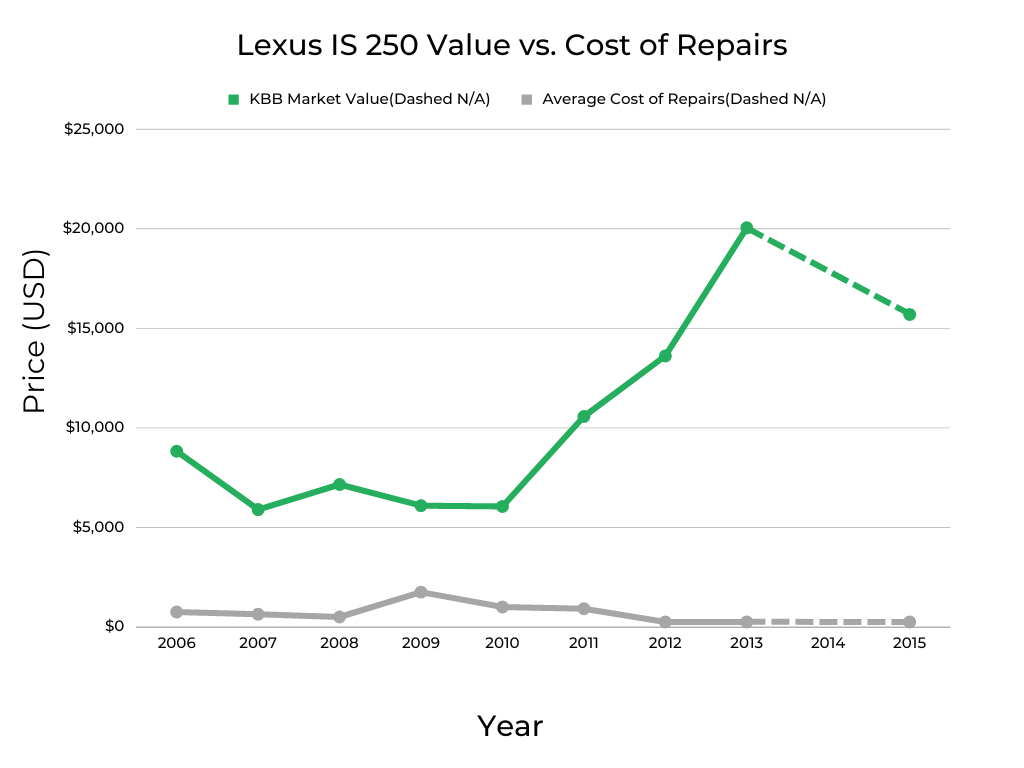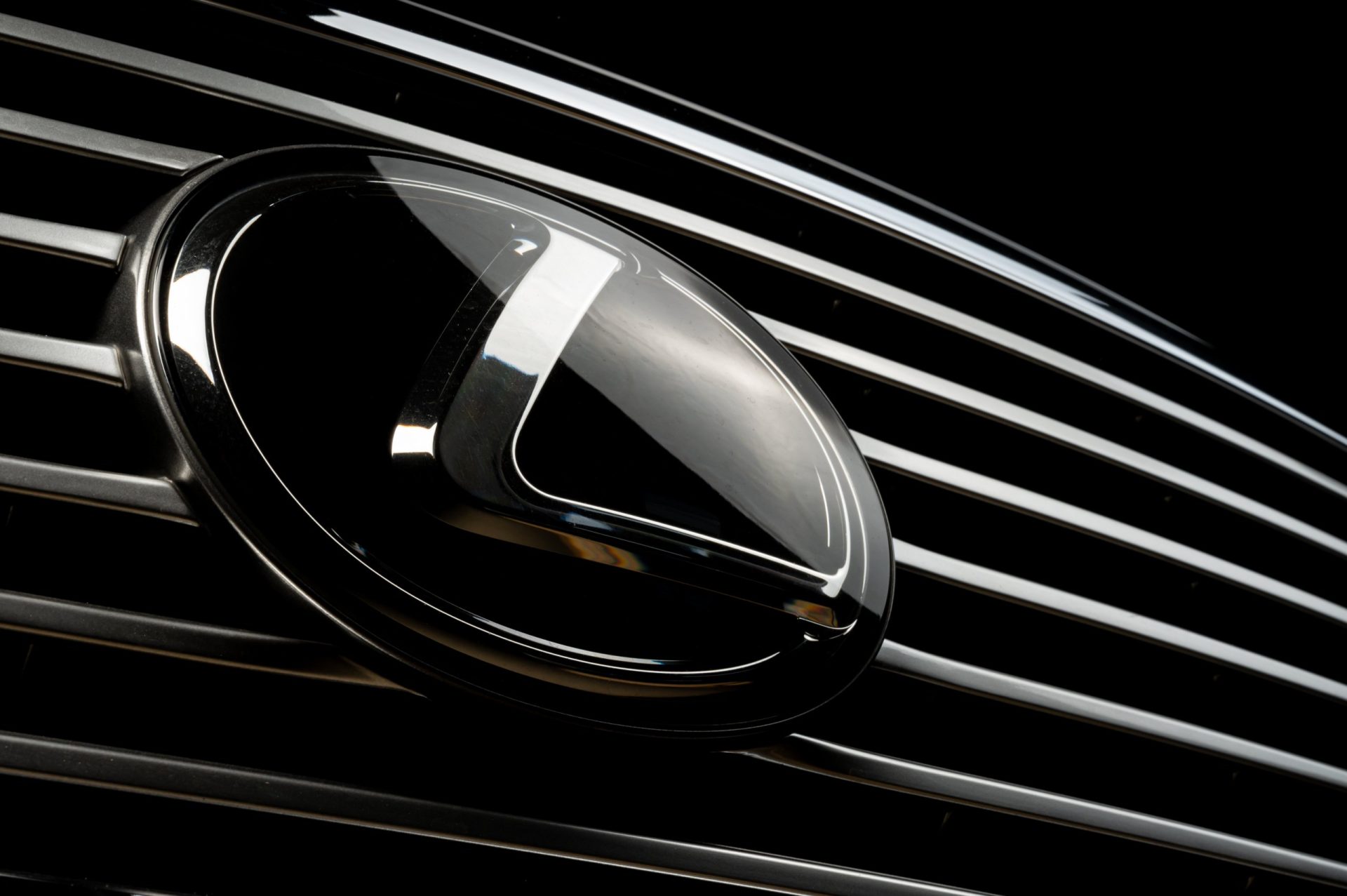Introduced over 20 years ago, the Lexus IS has been a mainstay of the luxury sport sedan market ever since. The IS 250 model, which was produced over two generations between 2006 and 2015 offered strong V6 power and the high-end craftsmanship Lexus has built its reputation on.
Though Lexus – and parent-company Toyota – reliability is highly regarded, there are always going to be some years of a vehicle that performs better than others. To that end, we’ve analyzed almost 10 years of FIXD reliability data to determine the best and worst model years of the Lexus IS 250.
Lexus IS 250 Engine Reliability Score, Safety Ratings, MPG, and Value vs. Maintenance & Repair Costs Year by Year
The first chart below, Lexus IS 250 Reliability Score, holds the most sway in our ranking of the best and worst model years. It illustrates objective FIXD device data against subjective owner-reported information that combines to give us a full picture of IS 250 reliability over its entire production run.
Typically, the first model year of a new generation of any vehicle struggles with reliability as the manufacturer irons out production kinks. Though we do not have data on the 2006 and 2014 IS 250 – both of which marked the start of a new generation – you can see examples of this with competitors like the Infiniti G35 and Audi A4.
To create a more well-rounded analysis, we factor in published government safety scores from the National Highway Traffic Safety Administration (NHTSA), fuel efficiency figures per fueleconomy.gov, current market values from Kelley Blue Book (KBB), and annual maintenance costs per owner-submitted survey responses.
Where applicable, we note frequently encountered Diagnostic Trouble Codes (DTCs) and important safety recalls issued by the NHTSA.
Our objective is to help current owners and would-be buyers of the Lexus IS 250 learn about the positives and negatives of each model year. On that topic, if you’re in the market for a car, take a look at our article on the USA’s most reliable and cheapest to repair cars in the U.S. Don’t get stuck with a lemon, use our data to help you shop.
Engine Reliability Score – Over The Years

The FIXD Reliability Score (green line) on the Lexus IS 250 Reliability Score chart above is based on the total number of CELs that have been recorded by customer-installed FIXD devices for each model year. After tallying them up, we weight this objective score by average mileage and convert it into a 1-10 scale where 10 is the best and 1 is the worst.
To generate the Owner Reliability Score (gray line), we surveyed IS 250 owners, asking, “How reliable would you say your car is?” Answer options range from “Just Point A to Point B driving” to “I could take a cross-country trip, no problem.” After converting the responses into a 1-10 scale, we can create this subjective counterpoint to the objective FIXD data.
Normally, these two lines follow similar trends, but as you can see above, the scores move in opposite directions for the most part. They do come close together in 2010 even though owners rate this model relatively low and in 2015, we can see the reliability gap closing.
That gap, however, was quite wide in 2007, which is not unusual for older model-year vehicles. This is likely due to long-term owners becoming sentimentally attached to their IS 250 and shrugging off reliability issues as the norm. We’ll go into more detail on this variance in the 2007 IS 250 section below.
Including both sets of reliability data allows for two dramatically different perspectives on the IS 250, which is intended to help buyers make an informed decision. You can find out more about our reliability scoring process at the bottom of this article and learn about some of the most common CELs to expect from a Lexus IS 250.
NHTSA Safety Score – Over The Years

The green line on the Lexus IS 250 NHTSA Safety Rating chart above is based on the average safety score, for all trim lines, of a given model year. It is overlaid with the average safety rating of the entire auto industry (gray line) to give a reference point for IS 250 safety. In both cases, the figures come from published NHTSA safety data.
As you can see, the Lexus either meets or exceeds the industry every year it was in production. In 2011, the NHTSA instituted more stringent crash-test protocols that caused an industry-wide dip in safety scores. However, the IS 250 showed a minimal reduction that year, which underscores its reputation as a safe car.
Understanding how a given model year of the Lexus IS 250 ranks for safety is important as it plays a main role in keeping insurance premiums down. If you live in one of the states listed below, we can show you the cheapest vehicles to insure in yours.
| What Used Cars Are the Cheapest To Insure In: |
| Ohio |
| North Carolina |
| Michigan |
| Georgia |
| Texas |
| New York |
| Illinois |
| Pennsylvania |
| California |
MPG – Over The Years

To create the above chart of Lexus IS 250 Average MPG, we average the combined fuel economy figures – from fueleconomy.gov – for all IS 250 trim lines of each model year.
As is typical of most vehicles, the IS 250 gets better at sipping fuel over time as technologies enable a more efficient powertrain. However, it’s a relatively muted improvement with the IS 250 as the same 2.5L V6 has provided motivation since day one.
Horsepower and torque output have also remained constant, but one relatively major change occurred when Lexus dropped the manual transmission from the IS 250 lineup in 2013. As you can see, this pushed average fuel economy to its highest point of 24 mpg.
Current Market Value of All Lexus IS 250 Years & Cost Per Year to Repair and Maintain Each

The above chart of Lexus IS 250 Value vs. Cost of Repairs plots current IS 250 market values per Kelley Blue Book against average annual maintenance costs collected from owner survey responses. It’s one more piece of the puzzle when it comes to determining the best and worst model years of these Lexus sport sedans.
The IS 250 has a somewhat unusual market value dataset as most vehicles follow a general uptrend over time – newer cars tend to be more valuable. However, the Lexus hovered under $10,000 until 2010 before hitting an uptrend in 2011.
There is no obvious reason for this market value trend as the third generation model didn’t arrive until 2014. But a relevant example for this chart is the 2009 IS 250. Reliability improved marginally that year, but as you can see on the graph, annual maintenance costs spiked up. That spike is nearly triple the average for this metric and is one reason we don’t recommend the 2009 model.
When shopping for a used Lexus IS 250, it’s important to keep in mind that not all vehicles are cared for equally. To protect yourself from lemons, take along a FIXD Sensor on your test drive. FIXD connects to a free app on your smartphone to tell you more about the vehicle you’re checking out, including check engine lights and other hidden issues that the owner or dealership may be attempting to hide. Click here to learn more and get FIXD for only $19.99 (regular price $59)!
Important Features Timeline

2006 – IS 250 debuts as a 2nd-gen model replacing the IS 300
2007 – X package offered with a firmer suspension calibration
2008 – Front seat backs are revised to add more rear legroom, and steering is retuned
2009 – Minor exterior styling updates, more advanced stability control system
2010 – Convertible model added to the lineup along with Safety Connect telematics system
2011 – F Sport package offered with unique wheels, body styling, and suspension settings
2012 – Carryover year with no major changes
2013 – Manual transmission dropped, Enform suite of smartphone apps arrives
2014 – 3rd-gen IS 250 arrives with more cabin space and new advanced driver assistance aids
2015 – Siri Eyes Free made standard, AWD models offer heated steering wheel
The Best Years of the Lexus IS 250

Taking into account FIXD and Owner reliability, fuel efficiency, and IS 250 owner survey responses, we’ve come up with this list of the best Lexus IS 250s. Pertinent recall information and notes about common DTCs are included as well.
NOTE: The 2006, 2012, and 2014 models are not included in the rankings below due to insufficient data.
2015 Lexus IS 250

FIXD App Engine Reliability: 7/10
Owner-Reported Reliability: 10/10
KBB Value: $15,693
Fuel Economy: 24 mpg
Annual Maintenance/Repair: $250
Safety Rating: 4.6/5
From high marks for both the FIXD Reliability and Owner Reliability Score to high points in both safety ratings and fuel economy, it’s easy to make the case that the 2015 Lexus IS 250 is the best of the best model years. It also happens to be the final year of the compact Lexus, which means the automaker had ample time to hone reliability.
Market values do show a decline versus 2013, but that makes for a stronger purchase value in this case. Especially when coupled with annual maintenance costs that come in nearly $400 below average, spending less than half a day in the shop each year, and a small recall count of just two.
Both recalls were for the convertible specifically and had to do with faulty airbags. Any Lexus dealership should repair recall-related work free of charge on a Lexus vehicle up to 15 years old. You can use this NHTSA VIN tool to find out if your car has any outstanding recalls.
These relatively late-model IS 250s are lauded by their owners for having comfortable seats, which is an area that Lexus focused on with the release of the 2nd-generation the year before. The automaker noted an improved driver seat position with more headroom and lateral support.
A large group of those owners also noted an easy-to-use entertainment system. That system consists of an 8-inch display with voice recognition and a Siri Eyes Free mode, the latter of which was added in 2015.
Those in the market for one of these IS 250s that appreciate good music should look for a model with the optional Mark Levinson 15-speaker audio system, a feature that likely drove the high number of owners citing a great sound system.
And if you’re wondering what the most frequently encountered problem areas are, look to the spark plugs. Both DTC P0300 and P0304 are triggered by engine misfires and usually mean it’s time to replace the spark plugs, a job that costs between $60 and $170 at a shop.
When DTC P0171 lights up, it means the air-to-fuel ratio is out of balance as we talked about in this DTC P0171 explainer video. Common causes of this issue are a vacuum leak or a dirty Mass Airflow (MAF) sensor.
2010 Lexus IS 250

FIXD App Engine Reliability: 7/10
Owner-Reported Reliability: 4/10
KBB Value: $6,053
Fuel Economy: 22 mpg
Annual Maintenance/Repair: $1,000
Safety Rating: 4.5/5
Halfway through 2nd-gen production, the 2010 Lexus IS 250 posted a 3-point improvement in its FIXD Reliability Score. Going back another year to 2008, this increase jumps to 6 points, which is significant particularly when considering the 2008 IS 250 earned a bottom-of-the-barrel 1 out of 10 for this metric.
Though it doesn’t have an impact on the impressive safety rating, it’s worth pointing out that Lexus made Safety Connect standard in 2010. This telematics system includes automatic collision notification and a stolen vehicle locator.
It’s not all rosy as annual maintenance costs come in above average, but they did post a drop over the previous year. Owners were impressed by the driver visibility, ease of use for the entertainment system, and rockin’ stereo. On that last point, would-be buyers might like to know that these 2nd-gen models came standard with 13 speakers.
When issues arise, DTC C1201 and C1241 are two of the most common causes of a CEL on any IS 250, including the 2010 model. DTC C1201 is related to an issue with the Engine Control Module (ECM) that can lead to problems with the Vehicle Stability Control (VSC) system, while C1241 usually means the battery voltage is too low.
DTC P0300 is triggered when multiple engine misfires are detected as we discuss in our DTC P0300 explainer video. Plan on replacing the spark plugs, a job that costs less than $170, when this issue comes up.
There were 9 recalls issued by the NHTSA for the 2010 Lexus IS 250. Of those, 4 were airbag-related as these models were part of the industry-wide Takata airbag fiasco.
The Worst Years of the Lexus IS 250

Working with the same information to determine the best Lexus IS 250s, we’ve compiled a list of model years to stay away from. You can expect worse reliability and bigger maintenance bills with these poor-performing IS 250s. We are starting from the absolute worst and progressing to the “best of the worst”.
2007-2008 Lexus IS 250

FIXD App Engine Reliability: 1/10
Owner-Reported Reliability: 7-8/10
KBB Value: $5,897-$7,156
Fuel Economy: 22 mpg
Annual Maintenance/Repair: $500-$639
Safety Rating: 4.5/5
Why are the 2007 and 2008 Lexus IS 250 rated worst of the worst? Because both years score a 1 out of 10 for the FIXD Reliability Score, which is the lowest possible rating. On top of this, the owner-reported reliability score trends down over this period.
Though the subjective owner score trended down, it still rated far higher than the objective FIXD score, especially in 2007. That year, owners gave the IS 250 an 8 out of 10 versus just 1 out of 10 per FIXD data. Drilling into that data reveals an important distinction between these two metrics.
According to surveys, 60% of 2007 IS 250 owners would happily take their Lexus on a cross-country road trip. However, that model year posted 2.6 times more DTCs than the average across nearly 10 years of FIXD data. You can learn more about our scoring process at the bottom of the page, but suffice it to say, the 2007 IS 250 stinks.
Need another reason to avoid these IS 250s? Here are two – there were 11 recalls issued for both model years.
Of the 11 recalls for the 2007 IS 250, one for engine valve springs failing – while driving – was the most significant as it impacted 138,000 vehicles. An issue with fuel delivery pipe corrosion was one of the more serious of the 11 recalls on the 2008 model as it affected some 214,000 vehicles.
These IS 250s also have a couple of frequently encountered DTCs with big-ticket repair bills, which correlates with the 4 days each year the 2008 model spends in the shop – that’s 4 times higher than average.
DTC P0420 and P0430 are both related to problems with the catalytic converter. Our DTC P0420 guide goes into more detail, but a new catalytic converter costs upwards of $2,000. With these IS 250s, DTC P0430 is specifically related to an issue with the exhaust piping, but that job will still set you back well over $1,000.
If DTC C1201 pops up, look for an issue with the ECM that is triggering related issues with the VSC and Traction Control systems.
It’s not all bad news as owners largely find the seats in these early IS 250s to be comfortable. This is important as they also spend a lot of time behind the wheel with 60% or more of them reporting using their Lexus primarily for lots of driving either for commuting or travel.
But, a below-average group of these owners expect to see 200,000 miles in their IS 250, and an above-average – as in 10 times more than average – contingent does not think their Lexus will hit that milestone. Bottom line? We strongly recommend avoiding the 2007 and 2008 Lexus IS 250.
2013 Lexus IS 250

FIXD App Engine Reliability: 1/10
Owner-Reported Reliability: 10/10
KBB Value: $20,048
Fuel Economy: 24 mpg
Annual Maintenance/Repair: $250
Safety Rating: 4.4/5
Usually, when a vehicle nears the end of a generation, reliability improves as any production kinks have been worked out. This is not so with the 2011 Lexus IS 250, which marked the end of the 2nd generation and a FIXD Reliability Score of just 1 out of 10.
These models have solid safety ratings, low upkeep costs, and posted better fuel economy than the prior year thanks to Lexus discontinuing the manual transmission (we’re pouring one out for our enthusiast friends), but any potential buyers should be careful not to overspend.
The KBB market value figure on these 10-year-old IS 250s jumped more than $6,000 versus the prior year. That is certainly good news for anyone looking to sell their 2013 model, but considering the terrible reliability, it also means a buyer could be dramatically overpaying.
Though we don’t suggest buying one of these cars, if you do, it’s worth noting that 50% of surveyed owners report using their Lexus for luxury driving duty. That’s far higher than average and correlates with a model year that offered high-end amenities like climatized front seats, perforated semi-aniline leather upholstery, and genuine maple wood trim.
One of the most common causes of an IS 250 CEL, DTC C1241, shows up with regularity on these 2013 models. Fortunately, it can often be corrected by charging the battery. If you encounter DTC P0101, it means the MAF is malfunctioning, which can cause an increase in fuel consumption.
Another common problem point is DTC P0300, which is triggered when multiple random engine misfires are detected. We dive deep on this subject in our DTC P0300 YouTube video, but expect to pay between $60 and $170 to correct this issue with a set of new spark plugs.
There were just 3 recalls for the 2013 Lexus IS 250, but all of them were related to exploding airbag inflators, which combined to affect some 3 million vehicles.
2009 Lexus IS 250

FIXD App Engine Reliability: 3/10
Owner-Reported Reliability: 6/10
KBB Value: $6,091
Fuel Economy: 22 mpg
Annual Maintenance/Repair: $1,750
Safety Rating: 4.5/5
The 2009 IS 250 is the unusual vehicle that improves its FIXD Reliability Score – by 2 points over the prior year – but still ends up on the wrong side of the model year rankings. Not only that, the score of 3 out of 10 is actually better than the 2011 model below which earns “best of the worst” honors with its score of 2 out of 10.
We came to this conclusion for two reasons. One, a FIXD score of 3 is very low even though it represents an improvement. Two, the annual maintenance costs for these Lexus models shoot for the sky at $1,750. That’s nearly 3 times higher than average and far too big a number to put these models on the list of best model years.
So it’s unsurprising these IS 250s spend more time in the shop each year than most. Granted, the average odometer reading of 175,000 is considered high mileage by most measures, but nonetheless, we are not going to recommend these cars to anyone. Reviewing owner survey responses doesn’t help as 40% say their IS 250 is expensive to repair.
One of the main drivers of this time spent on the lift is DTC C1424. It’s triggered by a faulty brake actuator assembly and correlates with the 60% chance of an expensive repair ($500+) being related to the brake system for the 2009 model.
DTC C1201 and C1241 are other commonly encountered causes of an IS 250 CEL for this model year. C1201 means there is a problem with the ECM and likely the VSC system, while C1241 pops up when the battery voltage is too low.
These 2009 IS 250s were part of a scary issue Toyota had with accelerator paddles becoming stuck – open. This issue was responsible for one of the 10 recalls on these models and affected some 3.8 million vehicles.
2011 Lexus IS 250

FIXD App Engine Reliability: 2/10
Owner-Reported Reliability: 7/10
KBB Value: $10,570
Fuel Economy: 23 mpg
Annual Maintenance/Repair: $917
Safety Rating: N/A
The 2011 Lexus IS 250 walks the line between the best and worst model years but is ultimately the “best of the worst” due to a 5-point drop in its FIXD Reliability Score versus the 2010 model. That’s far too significant a decrease to ignore and when combined with maintenance costs that lean high, we’re not going to recommend it.
There are bright spots like a slight improvement in fuel economy and KBB market values on the upswing. And Leadfoots will appreciate the F Sport package offered on these IS 250s that brought bolstered sport seats and a more aggressive suspension tune. This likely played a part in the relatively large group of owners saying they like to go fast in their 2011 IS 250.
Unfortunately, a lower-than-average percentage of owners expect to see 200,000 miles and a higher-than-average contingent thinks their Lexus is expensive to repair. That last note may be related to DTC P0430, a common cause of CELs on these models that typically results in a new catalytic converter to the tune of at least $1,500.
DTC C1201 and C1241 are back as frequently encountered trouble codes on the 2011 IS 250. An issue with the ECM and VSC system triggers DTC C1201, while C1241 pops when the battery voltage is too low.
Of the 4 recalls for these IS 250s, 3 were for airbag problems that combined to impact nearly 4 million vehicles. The 4th recall was due to windshield wiper arms loosening unexpectedly, an issue that affected 167,000 vehicles.
FAQs
What years of the Lexus IS 250 have engine and/or transmission problems?
The 2013 Lexus IS 250 has a 50% chance of an expensive repair being engine-related and the 2009 model comes in with a 25% chance of this happening. Both are quite a bit higher than the 17% average for this metric and both the 2009 and 2013 IS 250s land on our list of model years to avoid.
If you own a 2008 Lexus IS 250, be sure to stay on top of your automatic transmission service as these models have a 25% chance of the transmission being responsible for a $500+ repair. No surprise that these IS 250s are also on our Worst Model Year list.
What is considered high mileage for a Lexus IS 250?
Looking over nearly 10 years of IS 250 data, we can see that the average odometer reading is 111,000 miles, while the 2011 model hits a high point of 225,000 miles. With that in mind, it’s fair to say that 175,000 miles is considered high mileage.
That leaves about 50,000 miles of usable life before the powertrain says goodnight. And considering only 2 model years – 2007 and 2009 – come in around 175,000 miles, we can see that most models are still working their way towards this mark.
What other vehicles should I consider?
The luxury sport sedan segment is broad, but some of our favorite Lexus IS 250 competitors include the Infiniti G35, Audi A4, Cadillac CTS, Mercedes-Benz C-Class, and BMW 3-Series.
What do owners of the Lexus IS 250 like to use their car for?
| Frequent Use Categories: | How Useful? (Out of 5 Stars) |
| Family Vehicle | *** |
| Lots of Driving (travel/long commute) | **** |
| Hauling/Towing | * |
| Office on Wheels | * |
| Sport/Fast Driving | ** |
| Luxurious Driving | ** |
| Outdoor/Off-Road | * |
A Note About Data and Information Sources
This article has many details about the Lexus IS 250’s reliability; here’s what we used for our assumptions and recommendations.
- FIXD Reliability Score & Data: Engine reliability information is captured via the FIXD App.
The FIXD Reliability Score is calculated using the number of DTCs per year, weighted by mileage. This is then turned into a scale of 1-10 for easy graphing.
This is an objective score.
- Owner Reliability Score & Data: This data is the result of surveying Lexus IS 250 owners who use FIXD.
The Owner Reliability Score comes straight from owners of the Lexus IS 250.
This is a subjective score.
To determine the Owner Reliability Score we ask each car owner:
How reliable would you say your Lexus IS 250 is?
a. Just point A to point B driving
b. A Daily Commuter
c. Good for a 100-mile road trip
d. Good for a 500-mile road trip
e. I could take a cross-country road trip, no problem
From here we translate their answers into the Owner Reliability Score:
a. = 2
b. = 4
c. = 6
d. = 8
e. = 10
Keep in mind, owners may think their car is more or less reliable than it actually is.
One potential problem is that people often buy the same make or model they are used to when they go car shopping, just a newer year.
Ford, for instance, has a number of consumer loyalty awards for the Ford F-Series, Ford Mustang, and Ford Expedition.
Car owners may be so loyal to the make or model they currently own that they would have trouble accurately comparing their cars’ reliability to others.
It’s for this reason that we ask car owners a question that is relative to mileage rather than relative to other cars.
Still, be mindful of the accuracy of these Owner Reliability Scores, people’s perceptions and unconscious blindspots can skew data.
We suggest looking at both the FIXD Reliability Score and the Owner Reliability Score for this reason.
- KBB Value: Average private-seller valuations as supplied by Kelley Blue Book (KBB), based on a Lexus IS 250 with typical mileage for that respective model year.
- Fuel Economy: Mileage-per-gallon estimates according to the EPA MPG on Fueleconomy.gov
- Annual Maintenance/Repair: Upkeep expenses as reported by surveyed Lexus IS 250 owners
- Safety Rating: Crash test data collected and reported by NHTSA. We average all ratings for each year to come up with a simplified, average safety score. This makes it easier to look at on a graph.
References
- Lexus IS 250 model-specific information. Retrieved October 3, 2023, from https://www.edmunds.com/
- Lexus IS 250 model-specific recall information. Retrieved October 3, 2023, from https://www.nhtsa.gov/recalls
- Lexus IS 250 model-specific information. Retrieved October 3, 2023, from https://www.auto-brochures.com
- Lexus IS 250 model-specific information. Retrieved October 3, 2023, from https://pressroom.lexus.com/

Niel Stender grew up doing replacement work on his old Cherokee and sweet Mitsubishi Starion, which led to a degree in mechanical engineering and a job at Ford as a vehicle dynamics engineer. His writing infuses that automotive background with sales and marketing experience. Writing about cars for close to a decade now, he enjoys digging into some of the more technical mechanical systems under the hood and throughout a vehicle.















